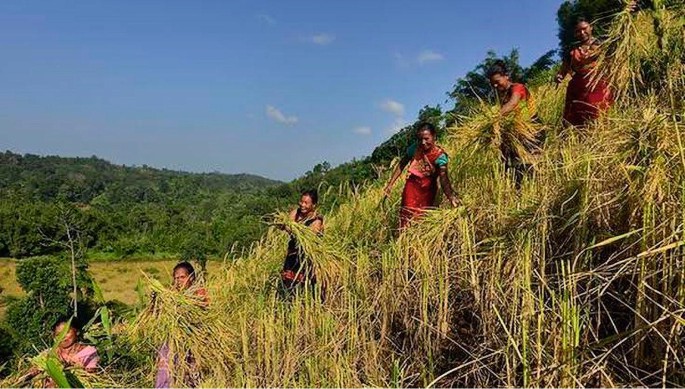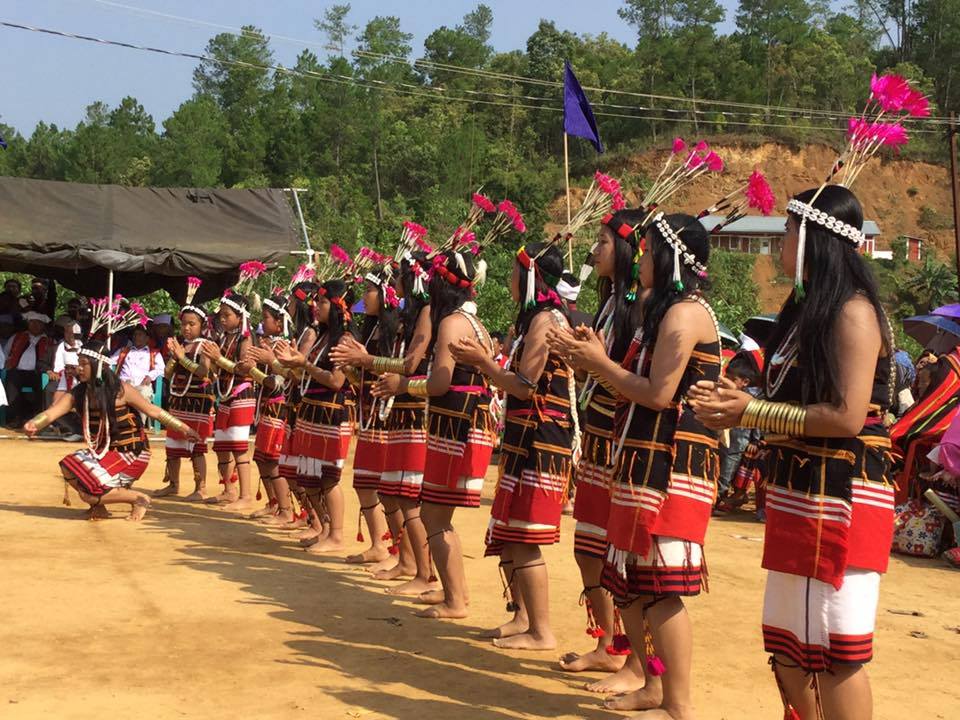By Dhaneswar Engti
Jhum cultivation is a kind of slash and burn method of agriculture. It is a process of growing crops in the hill slope by clearing the land of trees and other vegetations. Jhum cultivation has a long history that every tribal family of the hills is aware of it. The hill slope is thereafter cleared by slash and burn method before starting the jhum cultivation, and thus it has made the area cultivable of paddy and other important crops in the entire jhum field. Jhum cultivation is an arduous form of cultivation; hence all the members of the family have to participate during clearing and burning of the jhum field. They also work together during the sowing and harvesting occasions in the jhum field. The hill slopes are selected for jhum cultivation temporarily and then abandon it for a period of one to two decades to recuperate the soil’s fertility and reverts to its natural state. Thus, the Karbi people of the hills cultivate jhum cultivation together in large patches in the hill slopes every year during the days of old. We all know that burnt soil contains potash which increases the nutrient content of the soil and it contributes a speedy growth of crops in the jhum fields. But, jhum cultivation involves the felling of large number of trees and bamboos for temporary cultivation, and thus jhum cultivation is blamed for deforestation, soil erosion and loss of biodiversity which automatically affects drastic climate change to the mother earth.
Jhum cultivation is one of the most widely practiced systems of cultivation applied by the Karbis living in the hills. The jhum cultivation is called ‘Inglong Arit Katiki’ in Karbi language. The jhum cultivation is carried out by the hills Karbis for earning their livelihood. The jhum cultivation is one of the main sources of earning livelihood during the days of old. The Karbis have learnt this very art of jhum cultivation from their ancestors since time immemorial. These forest friendly people of the Karbi hills consider the jhum cultivation as one of the most trusted and dependable methods of earning livelihood. They consider forest as their deity who provides them food and shelter for a pleasant and healthy living. Hence, they like to worship the natural world (Forest) every year, so that, they are blessed with good quality of crops and heavy harvesting from their jhum fields.
The Karbis are animism by faith, - the belief that natural objects, natural phenomenon, and the universe itself possess souls. Therefore, the Karbis worship forest, river, hills and other natural objects as their gods and goddesses, and they like to take in the natural world as “Than Arnam”. This kind of annual ritual is called “Rongker Karkli” or “Than Arnam Kachipame” in Karbi. And because of these reasons the Karbis are very friendly with the natural world. Hence, they like to call the nature as the main feeder and only hired hand of all living and nonliving things of this world. The belief that natural objects have souls that may exist apart from their material bodies is the main credence of Karbi’s philosophy of life behind the nature worship.
The socio-cultural conditions of the Karbis are closely interconnected with the culmination of jhum cultivation. It is assoc iated with the development of its culture and literature. The jhum cultivation is the breeding ground of Karbi folk songs and Karbi folk dances during the olden days. The rich culture and folk literature of the Karbi tribe is interconnected with the beautiful natural world. It is the result of great assimilations with the ethereal environment of nature. The thick jungle, the habitat of wild animals, and verities of colourful wild birds have made the Karbi’s lifestyle more colourful and vibrant. The beautiful butterflies dancing in the pasture has added the Karbi culture more effervescent and aerated to take pleasure in. The beautiful rivulets of the hill slopes keep the Karbi hills evermore enchanting and delightful to see at all time.
The culmination of Karbi culture and literature could be noticed during the reign of great Karbi king, Rengbonghom. But the very structure of economy could not last long due to constant fights between the tribal communities. There was lack of mutual coexistence and loyalty among the tribal people of the hills during those days. Thus, the rural economy of the hills started to decline drastically due to constant warfare between the tribal people for claiming the supremacy over the other. As a result, it was beyond the proximity for the tribal people to achieve self-sufficiency both economically and politically. The tribal people of the hills had to suffer from poverty and diseases on a regular basis. During those days, jhum cultivation was the only means of livelihood of the Tribal people. Other than jhum cultivation, there was no other sustainable source of livelihood in the hills.
Jhum cultivation is also called as shifting cultivation. It is an agricultural system in which plots of land are cultivated temporarily, then abandoned while post-disturbance fallow vegetation is allowed to freely grow while the cultivator moves on to another suitable plot. The period of cultivations is usually terminated when the soil shows signs of exhaustion or when the jhum field is overrun by wild plants.
Now, let us come to the following important stages of jhum cultivation usually performed by the Karbi tribe since the age of old in the Karbi hills. The jhum cultivation as practiced by the hills Karbis can be broadly divided into 7 (seven) stages. The names of those seven stages are as follows:
1. RIT KECHAM
2. RIT KEPAN
3. ME KEKAI
4. ARHEK KARHI
5. RIT KENONG
6. BAP KARLU
7. SOK KEROT LAPEN KEROI
Now, let me expertise an effort to put in plain words about the seven stages of the jhum cultivation one by one in details. There are certain stages of jhum cultivation which are required to be performed diligently by the jhum cultivators.
1. RIT KECHAM:- Rit Kecham is the selection of jhum sites. It is the primary stage of jhum cultivation to be carried out by the Karbis in the Karbi hills. It is a well preserved tradition which is strictly followed by every faithful Karbi people of the hills. Rit Kecham means selection of a suitable site for doing the jhum cultivation by the hills Karbis. This initial stage of jhum cultivation is called ‘Rit Kecham’. The headman of the family or any adult member of the family goes to the forest for identifying the area and selection of site for performing the jhum cultivation for the calendar year is finalised. A suitable plot of land in the hill slope is generally selected for jhum cultivation by the farmer, where a significant mark is given by erecting with bamboos signifying that the plot of land is reserved for jhum cultivation by him and nobody would occupy that plot of land for that year. Thus, the practice of jhum cultivation starts in the hill slopes without inviting bigotry among the tribal people.
2. RIT KEPAN:- Rit Kepan is the clearance of forest for undertaking the jhum cultivation in hill slopes. After selection of site for jhum cultivation, the most gruelling stage of its cultivation starts. At this stage, land is cleared by slash-and burn methods.
All the trees, bushes and wild plants are cleared by the method of slash-and burn, and the left over and other lingering vegetations on the jhum field are desiccated completely before sowing the crops.
Later than that, the seeds are sown after arrival of rain to the jhum field. Here, at this stage, the farmers have to lacerate all the bamboos, trees and other unwanted plants entirely at a time, and then allows to dry up lacerates under the scorching heat of sunlight. The clearance of jungle is another important stage of jhum cultivation. It has to be done in such a way that none of the trees or wild plants can breed the area and destroy the crops any more. Hence, one has to do through slash and burn method to clear all the trees and wild plants at a time properly, so that, the sunlight can plunge directly into the jhum field at all time, and the crops can grow uninterruptedly to make possible of a good harvesting of crops from the jhum field.
3. RIT ME KEKAI:- Rit Me’ kekai is a process of burning of cut trees, dry bamboos and other unwanted dry plants at the jhum field. Rit Me Kekai, (Burning of fire), is the third stage of jhum cultivation. All dry bamboos, trees and other unwanted wild plants are burnt to ashes in the third stage of the jhum cultivation. At this stage the farmer starts burning all the dry objects in the jhum field, and it is one of the most exciting stages of jhum cultivation. When the dried bamboos, trees and other wild vegetations are burnt into ashes and a huge fire starts burning in the jhum field. Thus, the burnt soil starts containing potash which increases the nutrient content of the soil and it contributes a speedy growth of crops in the jhum fields.
By burning trees, bamboos and other wild vegetations in the jhum field, it enhances potash component of the soil tremendously. Thus the jhum field becomes a rich and arable soil for jhum cultivation. It also increases the nutrient content of the soil. After burning out of all desiccated bamboos, trees and other unwanted wild plants of the jhum field, the soil becomes red and loamy, and thus increases the soil more loamy and fertile which is very helpful for producing good crops and heavy production.. Hence, the jhum site is nicely cleared and all the unwanted wild plants and redundant objects are burn into ashes first, so that, the sunlight can fall directly on the jhum field for helping the speedy growth and heavy harvesting of crops from the jhum field. It is a well-known fact that, burnt soil contains maximum potash which increases the nutrient content of the soil and it can contribute a speedy growth of various crops in the jhum fields.
4. ARHEK KARHI:- Arhek Karhi is a collection of unburned bamboos, trees and other materials and again burning them to ashes in the jhum field. Arhek Karhi is the fourth stage of jhum cultivation. At this stage, burning of unwanted trees, weeds and other wild vegetations of the jhum field are carried out. It is another important stage of slash and burn method of jhum cultivation in the jhum field. This is a stage when all residual plants and trees and other unwanted materials are uprooted and burn into ashes again in the jhum field. Here, at this stage, all the dried bamboos, trees and other unwanted objects are collected properly and assembled at one place in total and then burn them to ashes completely, so that, these unwanted objects cannot prevent the crops from growing and the paddy and other essential crops are harvested from the jhum field nicely.
5. RIT KENONG:- Rit Kenong is the sowing seeds in the jhum field. ‘Rit Kenong’ is the fifth stage of jhum cultivation. After clearance of the jhum field, the crops are sown by the farmers. The preparation of the jhum field for cultivation is a major task to get good production of crops. Therefore, the soil is beautifully prepared with the help of small spades by the young boys and girls. The seeds of paddy and other crops are sown in the jhum field by the farmers. During this stage of jhum cultivation, the seeds of crops are sown in the field by the members of the family and other young boys and girls of the village, which is called ‘Ajir Kachehui’. It is one of the most popular exercises of jhum cultivation. ‘Ajir Kachehui’ means exchange of work between the working peasants, through manual labour, they can help to each other, for that, no monetary payment or exchange of money against the manual labour is mandatory.
The existence of ‘Jirkedam’ also originated from ‘Ajir Kachihui’. It is also known as Jir kedam, which is a modern form of cooperative society, and it is the oldest form of a well-organized traditional education cum training system of various household works including jhum cultivation in Karbi society. The very institution of Jir Kedam is the breeding ground of various Karbi folk stories, folk dances, folk songs and many other Karbi love stories of the olden days. These customary exercises are still in vogue in the Karbi society. Thus, we can take it for granted that, all the Karbi folk narratives are closely interconnected and originated from the ‘Riso Aterank’, ‘Jir Kedam’ and the epicentre of those folk narratives is the Karbi Jhum fields.
6. BAP KARLU:- Bap Karlu is the most unavoidable but tedious act of uprooting the unwanted plants and weeds in the jhum field. Bap Karlu is another important stage of jhum cultivation. Because, without doing proper weeding or cutting the unwanted plant or wild grass from the jhum field, the paddy and other important crops cannot grow properly. Without performing ‘Bap Karlu’, one cannot expect a good harvesting from his jhum field. It may prevent the paddy and other crops from growing and good harvesting. The jhum field is a process of cultivation which allows paddy and other crops are allowed to grow freely while the farmer moves on to another plot of land for jhum cultivation the next year. At this stage all crops emerge full-grown crop and the entire jhum field becomes emerald green with paddy leaves and other delectable crops. The emerald green leaves of paddy start dancing at the gentle waves of breeze throughout the day, and it captivates a farmer while looking from his small hut called – ‘Mandu’ or ‘Hemtap’, called it a dovecote, erected in the middle of the jhum field. At this stage the farmer tries to remove the weeds and other unwanted plants from his jhum field very gently and thus the paddy and other essential crops are allowed to grow up freely without any interruption from them. By taking these kinds of precautions, a farmer can expect a good harvesting of crops from his jhum field, and it is a healthy process of crop-growing farming activity generally practiced by the Karbi tribe during the olden days.
7. SOK KEROT LAPEN KEROI:- Sok Kerot is harvesting of crops and Sok Keroi is last act of collection and storing of crops or paddy from the jhum field. ‘Sok Kerot Lapen Keroi’ is another most important stage of jhum cultivation. For a farmer, this stage is the testing stage of his luck and how much paddy he has accumulated in that very year is the most important matter to be decided. For a jhum farmer, this is one of the most important periods of jhum cultivation. It is the time to assess himself how much wealth he has accumulated in terms of paddy and other crops for that particular year. People are excited to see the heavy collection of paddy and other crops of a farmer. If there is a heavy collection of paddy from his jhum field, then it can be said that, his dream has come true, he will have enough foodstuff to eat for that year. He does not need to worry for that year’s livelihood. It is true for a farmer that, his whole year’s labour and sacrifice has rewarded him sufficient crops by the blessings of Hemphu Arnam, the almighty God. Hence, they worship ‘Hemphu Arnam’ to get more blessings from Him. The fruit of his hard labour is abundance now; his store house is full of paddy and other essential crops which are enough for the yearlong consumption of his family. It gives him enough satisfaction to live a good and satisfying life with his wife and other members of his family. It gives him complete food security for that particular year. It provides him more confidence to work harder the next year to earn additional wealth from the jhum field.
Further, during the harvesting season, all the young boys and girls participate in the collection of paddy with marry making. In the jhum field, every single stalk of grains is collected properly and to be kept at a place called ‘Jimtim’, which is nicely prepared in front of the ‘Mandu’. Mandu. It is erected in the middle of the Jhum field for the night’s stay of the farmer. After that, they make a good threshing of paddy with the sticks to separate the grains from the straws, and this is called -‘Sok Kepam’ in Karbi language. Singing and dancing is another important entertaining scene to be viewed during the harvesting period.






